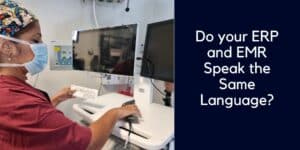What’s inside:
This blog looks at the operational and business benefits of product usage data captured at the point of care, and covers:
- How clinical documentation is used across different departments in hospitals and ambulatory surgery centers
- The importance of healthcare interoperability
- The three vital factors needed to optimize OR data
- The new way to document product usage in surgery
How clinical data is supporting hospital operational efficiency
Healthcare organizations are breaking down their silos, creating a closer relationship between clinical and operational departments.
There is growing need to ensure the fast flow of clinical data across organizations, and one important area is the transfer of information from the point of care.
The surgical setting provides source data that is used by other hospital departments to ensure the efficient management of patient care and hospital operations, including:
- Medical claims processing and billing
- Materials management
The EHR is often viewed as a clinical tool, but the data it contains plays a critical role in many operational tasks.
The importance of data sharing across healthcare systems
Although there may be a strong desire for departments to break down silos and work together, health systems, hospitals and ambulatory care providers are often restricted by the limitations of their software. This may be due to legacy systems, partial technology upgrades or siloed software, all of which affects interoperability.
Usage data captured during surgery needs to end up on the EHR, ERP, charge capture system and MMIS. It’s important for this vital data to reach all these systems, yet many organizations are struggling with this task.
It is clear that improved data flow across an organization can support improved business efficiency.
Healthcare organizations are currently fighting against negative margins, and improving surgical data capture is one very achievable way to boost performance.
Optimizing the data captured in surgery
In order for patient utilization information to have optimal value, it needs to meet these three criteria:
- Accuracy – There are so many different types and sizes of medical devices and implants, and recording the correct item used in surgery needs to be achieved. Each entry needs to include all relevant details, including the batch number, which is crucial in case of future product recalls. This may sound like a simple task but system limitations, lack of time for longwinded documentation and inefficient data capture tools, can all impede the accuracy of data captured.
- Completeness – It’s important that every item used in surgery is captured – and that includes more tricky items such as small implants like nuts, bolts and screws, and non-stock items, including trunk stock. These items are likely to be less straight forward to enter onto the system and are at the biggest risk of not being recorded at all.
- Timeliness – The data needs to be available to use within the timescales needed, for example, within the window for reimbursement.
Healthcare organizations can struggle with several (or indeed all) of these criteria.
Many try to manage the limitations of their systems by:
- Using workarounds during surgery
- Adding post-surgery sessions to record items that weren’t able to be captured during the procedure
- Undertaking documentation audits to check, correct or add any missing information.
All of these add labor costs and lengthen the process.
Simplifying surgical data collection
There are clear benefits to achieving full, accurate and timely data and charge capture at the point of care, as well as being able instantly share this data with core hospital systems.
Traditional point of use data collection methods have proven to be ineffective.
It’s time to try something new.
Snap & Go is revolutionizing surgical data capture by using image recognition technology and AI cloud software.
This new approach is a giant step forward.
Snap & Go makes capturing product usage data as easy as 1,2,3:
- Making it quick and simple for the circulating nurse to capture ALL item data in surgery.
- Automating the task of item identification and OR charge capture using a global SKU database, so that even items not on the local Item Master are recognized, identified and documented.
- Sharing the data with core hospital systems including the patient file on the EHR.
Snap & Go achieves the smooth flow of utilization data from the OR and procedure room,
to all those key hospital functions that require item consumption data for their workflows.

POU item tracking using computer vision and AI technology
Snap & Go uses new technology to simplify the task of data capture at the point of care, reducing the task to a 3 second item scan, that is similar to using a self-checkout at the supermarket.
Once the item is captured the role of the nurse is complete. Digital item identification and recording then takes place in the cloud.
The use of enhanced automation via cloud software enables 100% of the items used in surgery to be quickly and easily loaded onto hospital systems, without the need for post-surgery documentation or audits.
The business benefits of accurate item capture during surgery
By gaining full and accurate data from procedural and operating rooms, healthcare organizations can achieve clinical, operational and business benefits such as:
- Preparing full and timely claims to optimize revenue.
- Using data-driven inventory management to streamline the inventory and make stockouts and surpluses a thing of the past.
- Effectively handling any product recalls by accessing digital patient data.
It’s time to try out the new generation of point of use data capture.
Contact us for more information on improving data capture in your surgical spaces and find out more about our complete range data capture solutions for the surgical setting.
Clinical workflows provides the source data for many hospital functions. For example, consumption data from the point of care will update materials management that stock has been used so that they can accurately manage the flow of inventory and ensure the right stock is always at hand.
The EHR is the source of case costs compiled by the revenue cycle management team (RCM). When the data used by this team is complete, accurate and timely, they are able to submit correct and timely claims that optimize revenue.
Health systems, hospitals and surgery centers are complex organizations. Software systems, devices and tools are expensive and often healthcare organizations can have a range of different systems in place, for example there may be more than one type of ERP across an organization and there will also be a variety of other systems such as the EHR, charge capture system, material management system and point of use data capture system. This complex range of software is commonly unable to share or receive data, which creates data silos that hamper operational efficiency.
Surgical data should comply with three main elements; accuracy, completeness and timeliness. When data has all of these elements it becomes useful and supports wider organizational efficiency. Added to this is the ease of sharing this data between systems.
Healthcare organizations use a range of systems including stickers in books, manual data entry, QF codes, RFID scanners and barcode scanners for data collection in surgery. This technology is tired and inadequate, struggling to manage the complexity of the setting and task. Snap & Go is the newest method on the market, using image recognition, AI and ML technologies.
Snap & Go is able to quickly and accurately capture product usage data at the point of care, making the job easy and simple for the circulating nurse. It minimizes the supply chain task to just data capture and automates the tasks of item identification and documentation.
Snap & Go achieves quick and accurate data capture that supports optimized case revenue and reduced materials management costs. It reduces staff time spent on documenting usage. In addition, its built-in patient safety features protect patients, prevent ‘never events’ and result in reduced litigation by preventing usage of recalled or expired items.
Nurses feedback that recording usage documentation in surgery is a time-consuming and difficult task. They find Snap & Go a refreshing, easy-to-use surgical data capture system that just gets the job done.
Take a look at a video showcasing the main features of Snap & Go Feel free to contact us for further information.






